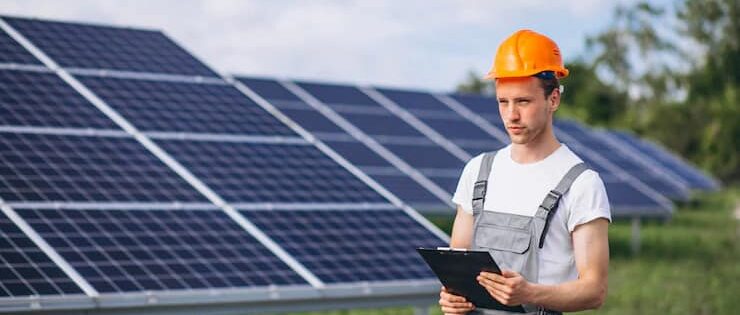Of all the issues plaguing the world in 2022, climate change is one of the most urgent ones. The rising global temperatures are drastically affecting nature, leading to rising sea levels, heavy rainfall, and forest fires.
This is affecting thousands of species of flora and fauna, making their current inhabitants inhospitable. Worse still, it’s also affecting humans, since it’s making the earth unsuitable for farming and decreasing the quality of the air we breathe. If you’re deeply concerned about the damage we’ve done to the planet, then you’ve likely researched ways to reverse it.
Out of all the solutions — recycling, cutting back on flying, meat consumption, and shopping for sustainable products — switching to solar energy stands out as the best, long-term option. The energy we can harness from the sun is an entirely green, pollution-free way to power up your home. Plus, it comes with many benefits, such as tax credits that make it a smart financial investment.
However, that doesn’t mean you can switch to solar overnight. First, you need to prepare your home so that it can bear a solar system. You also need a government grant to get your solar provider to install the panels on your property. How can you get a government grant for solar, you ask? Well, stick around for this step-by-step guide on how to make your home solar-friendly.
How to Make Sure Your Home is Solar-Ready
Ever since 2005, when solar energy started gaining popularity, the government began offering benefits to all solar-powered homes. This was meant to incentivize people to make the switch and thus reduce their carbon footprint. While it may have taken over a decade, solar energy is now more popular than ever, with people scrambling to get their own systems at a rapid rate.
However, that doesn’t mean installing a set is just a matter of making a phone call to your solar provider. First, you have to make sure your home is fit to house a solar system. There are several ways you can do this:
1. Check Your Roof
The most common misconception about solar power is that the panels don’t work in bad weather. This isn’t the case. The panels can still absorb the sun’s radiation, meaning they can work even when it’s overcast. However, to get the most out of your system, you should place it on your roof, where it’ll get a steady stream of constant sunlight.
To ensure your roof is suitable for a set of panels, inspect it for any loose or broken tiles, leaks, or stray wires and antennas. A set of panels can last around 20 years, so your roof needs to be able to handle them for that long.
2. Research Your Energy Expenditure
After preparing the property, you should research the types of systems you can install. The size and capacity of your panels will largely depend on the amount of energy you expend, daily.
For example, the average American home uses around 879 kWh of energy every month. Solar panels can generate between 350 to 850 kWh for a smaller residential system. Of course, the larger the system, the more energy it will make. So, if your house is bigger, make sure you invest in a system that can meet its energy consumption demands.
3. Explore Your Options
Another thing to consider when preparing your home for solar power is the provider you’ll contact for the installation. Different solar providers offer their services at different prices, with some, like Atlantic Key Energy offering higher quality at a lower cost. Consequently, you should explore which company fits your budget and goals the best.
4. Secure a Government Grant
The last check on your list should be to secure a grant. To ensure low-income households have equal access to clean energy, the government has started offering grants to anyone wishing to go solar. This grant can help you save up considerably on the cost of your system and make purchasing the panels easier and more lucrative.
A Breakdown of Government Grant for Solar
Getting a solar grant involves a bit more than just applying for it. First, you must make sure you meet the necessary qualifications.
For starters, the US Department of Energy Efficiency and Renewable Energy doesn’t offer grants to residential homes on the federal level. Instead, they aim to give grants to lower-income households, as well as farms, schools, and nonprofits in mostly rural areas.
Florida, for example, gives grants to agricultural producers who generate at least 50% of their gross income from farming. To qualify, you must be a US citizen and live in an eligible area. Likewise, you’re only permitted to use the funds for purchasing and setting up your system.
Overall, Florida offers grants that cover 25% of the total project costs. The Renewable Energy System grants have a $2,500 minimum and $500,000 maximum, which is more than enough to secure you a good system. To apply, check their website and read through the grants they currently offer and the necessary paperwork you’ll need to secure to qualify for them.
Key Takeaways
Solar power comes with many advantages — it’s renewable, eco-friendly, and good for your wallet. Likewise, it’s also easy to get, thanks to the numerous grants the US government offers its citizens. The grant can cover around 25% of the total cost of installation. Thus, you can easily switch to solar energy and start saving money and the planet today!
What Else to Know About Going Solar
Can Solar Panels Exceed Their Shelf Life?
Can I Install Solar Panels Somewhere Other Than My Roof?
How to Find the Best Solar Company Near Me?





